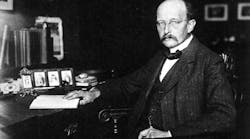The new polarization-matched LED, developed in collaboration with Samsung Electro-Mechanics, exhibits an 18% increase in light output and a 22% increase in wall-plug efficiency, which measures the amount of electricity the LED converts into light.
Problem: efficiency droop
The new device achieves a notable reduction in “efficiency droop,” a phenomenon that allows LEDs to be most efficient when receiving low-density currents of electricity, but then to lose efficiency as higher density currents of electricity are fed into the device.
“This droop is under the spotlight since today’s high-brightness LEDs are operated at current densities far beyond where efficiency peaks,” said project leader E. Fred Schubert, Wellfleet Senior Constellation Professor of Future Chips at Rensselaer, and head of the university’s National Science Foundation-funded Smart Lighting Engineering Research Center.
“This challenge has been a stumbling block, because reducing the current densities to values where LEDs are more efficient is unacceptable. Our new LED, however, which has a radically re-designed active region, namely a polarization-matched active region, tackles this issue and brings LEDs closer to being able to operate efficiently at high current densities,” Schubert said.
Solution: A new quantum-barrier design
Focusing on the active region of LEDs where the light is generated, Schubert’s team discovered the region contained materials with mismatched polarization, Schubert said.
The researchers discovered that the mismatch can be strongly reduced by introducing a new quantum-barrier design. They replaced the conventional gallium indium nitride/gallium nitride (GaInN/GaN) layer of the LED active region with GaInN/GaInN. This substitution allows the layers of the active region to have a better matched polarization, and in turn reduces both electron leakage and efficiency droop.
In October, Rensselaer announced its new Smart Lighting Research Center, in partnership with Boston University and the University of New Mexico, and funded by an $18.5 million, five-year award from the NSF Generation Three Engineering Research Center Program. The three primary research thrusts of the center are developing novel materials, device technology, and systems applications to further the understanding and proliferation of smart lighting technologies.






